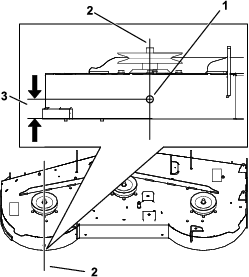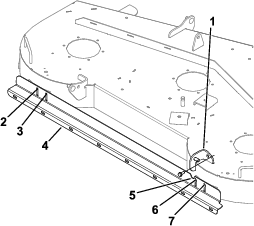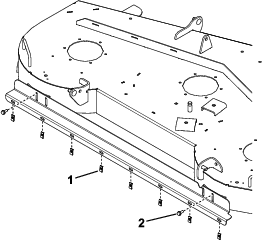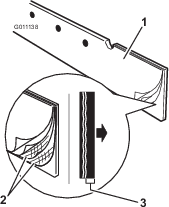Installation
Determine the left and right sides of the machine from the normal operating position.
Note: All graphics in these instructions show the kit on a 60in mower deck.
Preparing the Machine
-
Park the machine on a level surface.
-
Disengage the blade-control switch.
-
Engage the parking brake.
-
Shut off the engine and remove the key.
Removing the Mower Deck
Remove the mower deck; refer to the Operator’s Manual for the machine.
Installing the Kit
Parts needed for this procedure:
| Striping bracket | 1 |
| Wiper | 1 |
| Thread-forming bolt | 2 |
| Speed nut | 8 |
| Washer | 8 |
| Bolt | 8 |
-
For mower decks with rear skids::
Measure and mark 9.5 mm (3/8 inch) from the top of the left skid on a center line (Figure 1).

For mower decks without rear skids:
At the most rear point of the left baffle curve, aligned with the spindle shaft, measure and mark 48 mm (1-7/8 inch) from the bottom.

-
Drill a hole at the marked location using a 9/32 inch drill bit (Figure 1).
-
Using the bracket as a template, mark and drill a hole in the right skid using a 9/32 inch drill bit (Figure 3).
Note: Ensure that the notch in the bracket aligns with the right rear hanger bracket to allow clearance when adjusting the wiper height.

-
Install the bracket to the holes using 2 thread-forming bolts (Figure 4).

-
Install 8 speed nuts to the open holes in the bracket (Figure 4).
-
Position the wiper so that the rubber edge is forward and the fiber reinforced part of the cross section is to the rear (Figure 5).

-
Install the wiper to the bracket using 8 bolts and 8 washers (Figure 6).

Installing the Mower Deck
Install the mower deck; refer to the Operator’s Manual for the machine.
Operation
Adjusting the Height
Important: Applying excessive downward pressure with the striping bar may damage turf and the striping kit.
Important: Raise the mower deck to the transport position when not in use to avoid damaging the wiper.
Important: Avoid obstacles that can damage the kit. Temporarily lift the deck to transport position when performing turns or moving in reverse.
For best results from normal striping, set the bottom edge of the wiper at 6.4 to 1.3 cm (1/4 to 1/2 inch) below the bottom of the deck.
Adjusting the position of the wiper adjusts the height of the striping bar. There are slotted sets of holes to raise or lower the wiper (Figure 7). The mower deck can also be lowered or raised to the adjust the wiper height; however, this also affects the height-of-cut.
Avoid close trimming to reduce damage to landscaping and the striping bar. Replace the wiper yearly or more often as wear requires.

Operating Tips
Achieving Distinctive Striping
Grass Condition and Type
-
Limp grass where wheel tracks are very visible and cool-season grass types found in northern areas will usually produce more striping contrast.
-
Stiff grass where wheel tracks are less visible and warm-season grass types found in southern areas will usually produce less striping contrast.
-
Transition zone grasses found in the narrow belt region can produce more striping contrast in some areas and some portions of the growing season, while producing less striping contrast in other areas or portions of the season.
-
Some grass types produce better striping contrast when mowing short. Other grass types or moisture content of the grass can provide better contrast when mowing at a long/tall height of cut. Experiment with what works best in your situation.
Sun Position
This is how the light is reflected on the grass.
-
Mowing patterns that generally run east-west will have a greater contrast than north-south patterns.
-
The striping pattern contrast is less visible around noon and more visible in mornings and afternoons.
Viewing Position
The grass that is bent toward you will appear darker, and the grass that is bent away from you will appear lighter.
-
Mowing patterns that generally are parallel to a road will have greater contrast when viewed approaching or leaving the property. The contrast of striping will be less visible when looking across the mowing direction.
-
If the property has a focal point or a viewing location, mowing in a pattern that is generally to and from the observation point can be beneficial.
Lawn Condition
-
Large flat areas usually provide better striping contrast than on slopes or areas with a lot of trimming and edging.
-
Mowing in morning dew can produce good striping contrast.
-
Double-cut mowing and mowing a second pass at a 1.3 cm (1/2 inch) lower height of cut can produce good striping contrast.
Mowing Mode
-
Side dispersal of clippings can hide striping and reduce the contrast effect.
-
Bagging can display heavy wheel tracks and reduce the effect of striping.
-
Mulching will often display excellent contrast and enhance the effect of striping.
Landscape
-
The mowing area size has an effect on the final appearance. Large areas can look better when mowed with a large mower. Small areas may not look right when cut with a large mower.
-
Large areas with occasional trees or other obstructions will often look best when the mowing pattern appears to go through the obstruction. For example, it can look best for a pattern to match and continue on the far side of a small pond. A different cross cut pattern on the far side of a pond may not be visible.
-
Some areas look best with long straight lines of striping mowing pattern aligned with a property edge. Some areas look best with a diamond pattern, where neither straight line is aligned with the property edge. Properties with rolling hillsides or ponds can look best with a flowing curves striping pattern. A distinctive feature like a small pond can be highlighted and enhanced by a radial pattern or by a ring pattern.
Training the Lawn for Striping
-
On a new property during weeks 1 and 2, you may need to follow the exact same pattern and direction in the same wheel tracks. This will begin training the grass to bend in the desired direction.
-
On week 3, use a cross-grain striping pattern.
-
On weeks 4 and 5, repeat the original pattern. After you establish the primary striping-pattern grain, you may alternate the pattern each week to establish a checkerboard or a plaid style of mowing pattern.
-
Do not mow in the exact same pattern every week. This will cause compaction in wheel tracks and may produce ruts or depressions along the wheel tracks.
Turning While Using the Striping Kit
-
Raise the deck when turning. Striping is generally not enhanced by end turns.
-
Raising the deck will reduce blending ends of the pattern.
Driving the Machine to Different Cutting Areas
-
Raise the deck and drive along a previous cut path to transport from one area of the property to another section.
-
Driving across the pattern can disturb the pattern.
Following All General Mowing Common Practices
-
Mow the perimeter to establish a boundary.
-
When side discharging, direct the clippings away from walks, drives, flower beds, buildings and vehicles. If the discharge throws clippings a long distance, mow additional passes to avoid unwanted cleanup of clippings.
-
Avoid excessive trimming. Driving back and forth or frequent forward and reverse maneuvers around an obstacle will compress the grass and disturb the professional appearance of a nice job.
-
Follow all safe mowing practices as described in the Operator’s Manual. Do not let the striping pattern cause you to mow into a hazardous situation.